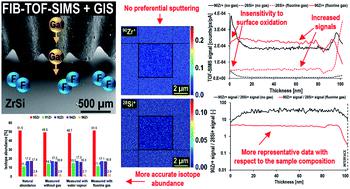当前位置:
X-MOL 学术
›
J. Anal. At. Spectrom.
›
论文详情
Our official English website, www.x-mol.net, welcomes your
feedback! (Note: you will need to create a separate account there.)
Potential of gas-assisted time-of-flight secondary ion mass spectrometry for improving the elemental characterization of complex metal-based systems
Journal of Analytical Atomic Spectrometry ( IF 3.1 ) Pub Date : 2020-10-09 , DOI: 10.1039/d0ja00372g Agnieszka Priebe 1, 2, 3, 4 , Tianle Xie 1, 2, 3, 4, 5 , Laszlo Pethö 1, 2, 3, 4 , Johann Michler 1, 2, 3, 4
Journal of Analytical Atomic Spectrometry ( IF 3.1 ) Pub Date : 2020-10-09 , DOI: 10.1039/d0ja00372g Agnieszka Priebe 1, 2, 3, 4 , Tianle Xie 1, 2, 3, 4, 5 , Laszlo Pethö 1, 2, 3, 4 , Johann Michler 1, 2, 3, 4
Affiliation

|
Enhancing the spatial resolution of Time-Of-Flight Secondary Ion Mass Spectrometry (TOF-SIMS), which provides 3D elemental distribution in combination with high sensitivity and molecular information, is currently one of the hottest topics in the field of chemical analysis at the nanoscale. As the efficiency of the ionization process determines the possibility of imaging a sample's elemental structure in 3D, methods for enhancing secondary ion generation are of particular interest. Recently, a novel approach of combining a high-vacuum compatible compact TOF-SIMS detector with a Gas Injection System (GIS) integrated within a Focused Ion Beam (FIB) instrument has been demonstrated on pure metals. In this work, we present a comprehensive study on water vapor and fluorine gas-assisted TOF-SIMS conducted on dedicated Zr-based model samples (ZrAl, ZrSi and ZrCu) to verify whether the application scope of this method can be expanded to more complex alloys. The main concerns of potential preferential sample sputtering and sample isotope abundance content degradation caused by the introduced gas were excluded. Moreover, fluorine gas improved the accuracy of the measured Zr isotope contents. In most cases, the ion yields were significantly increased. Furthermore, gas co-injection seemed to mitigate variations in element ionization along the thin film, allowing us to obtain more representative TOF-SIMS data regarding sample composition. Compared to the results obtained under standard vacuum conditions, the alloys' sputtering rates decreased by up to 46% when using water vapor and almost doubled in the case of fluorine gas.
中文翻译:

气体辅助飞行时间二次离子质谱技术可改善复杂的基于金属的系统的元素表征
增强飞行时间二次离子质谱(TOF-SIMS)的空间分辨率,提供3D元素分布以及高灵敏度和分子信息,目前是纳米级化学分析领域中最热门的主题之一。由于电离过程的效率决定了以3D方式对样品的元素结构进行成像的可能性,因此增强二次离子生成的方法特别受关注。最近,已经在纯金属上展示了一种新颖的方法,该方法将高真空兼容的紧凑型TOF-SIMS检测器与集成在聚焦离子束(FIB)仪器中的气体注入系统(GIS)相结合。在这项工作中,我们将对基于专门基于Zr的模型样品(ZrAl,ZrSi和ZrCu),以验证此方法的应用范围是否可以扩展到更复杂的合金。排除了由引入的气体引起的潜在优先样品溅射和样品同位素丰度含量降低的主要问题。此外,氟气提高了所测Zr同位素含量的准确性。在大多数情况下,离子产率显着提高。此外,气体共注入似乎减轻了沿薄膜的元素电离的变化,使我们可以获得有关样品成分的更具代表性的TOF-SIMS数据。与在标准真空条件下获得的结果相比,使用水蒸气时,合金的溅射率最多降低46%,而使用氟气时,溅射率几乎翻倍。
更新日期:2020-11-03
中文翻译:

气体辅助飞行时间二次离子质谱技术可改善复杂的基于金属的系统的元素表征
增强飞行时间二次离子质谱(TOF-SIMS)的空间分辨率,提供3D元素分布以及高灵敏度和分子信息,目前是纳米级化学分析领域中最热门的主题之一。由于电离过程的效率决定了以3D方式对样品的元素结构进行成像的可能性,因此增强二次离子生成的方法特别受关注。最近,已经在纯金属上展示了一种新颖的方法,该方法将高真空兼容的紧凑型TOF-SIMS检测器与集成在聚焦离子束(FIB)仪器中的气体注入系统(GIS)相结合。在这项工作中,我们将对基于专门基于Zr的模型样品(ZrAl,ZrSi和ZrCu),以验证此方法的应用范围是否可以扩展到更复杂的合金。排除了由引入的气体引起的潜在优先样品溅射和样品同位素丰度含量降低的主要问题。此外,氟气提高了所测Zr同位素含量的准确性。在大多数情况下,离子产率显着提高。此外,气体共注入似乎减轻了沿薄膜的元素电离的变化,使我们可以获得有关样品成分的更具代表性的TOF-SIMS数据。与在标准真空条件下获得的结果相比,使用水蒸气时,合金的溅射率最多降低46%,而使用氟气时,溅射率几乎翻倍。











































 京公网安备 11010802027423号
京公网安备 11010802027423号